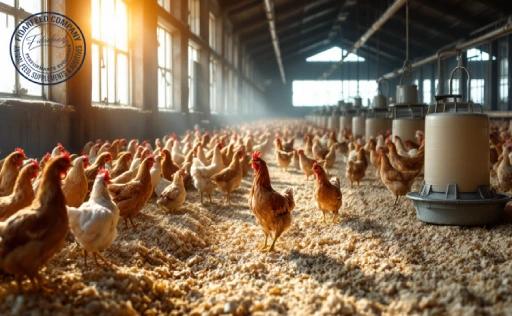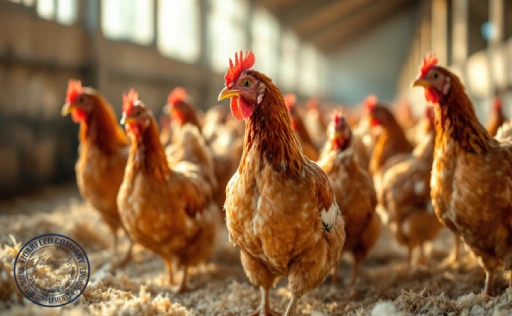Broiler Breeder Egg Production is a delicate process that requires careful management of multiple factors, and lighting is one of the most crucial. Whether you are an experienced breeder or just starting out, understanding how light influences egg production can significantly impact your farm’s efficiency and profitability. Lighting not only affects the laying cycle but also plays a critical role in bird health and fertility. By fine-tuning your lighting strategy, you can maximize egg yield, improve hatchability, and ensure a sustainable production system. Let’s dive into the science and practical applications of lighting for broiler breeder hens.
Why Lighting Matters for Broiler Breeder Egg Production
Light is more than just illumination; it is a biological trigger that controls reproduction in broiler breeder hens. The right lighting conditions stimulate sexual maturity, regulate hormone production, and ensure a steady egg-laying pattern.
Learn more about: Active Probiotic Yeast for Poultry
Without a well-designed lighting guide, hens may lay fewer eggs, develop reproductive disorders, or experience irregular laying cycles. By understanding the role of lighting, farmers can create an environment that enhances productivity and optimizes overall flock performance.
The Science Behind Light and Broiler Breeder Egg Production
Scientific research has shown that light influences the hypothalamus, a part of the brain responsible for releasing reproductive hormones. When hens are exposed to adequate light intensity and duration, their bodies produce more luteinizing hormone (LH) and follicle-stimulating hormone (FSH), which are essential for ovulation and egg production.
Learn more about: Probiotics’ Effect on Egg Production: Boosting Naturally
The wavelength of light also matters; red and orange spectrums are known to enhance reproductive performance, while blue and green light can have calming effects on the birds.
Optimal Lighting Guide for Maximum Broiler Breeder Egg Yield
A well-structured lighting schedule ensures that hens reach sexual maturity at the right time and maintain high egg production rates. Here’s a recommended program for broiler breeder hens:
Learn more about: Complete Guide to the Management of Breeding Stock and Broilers
- Chick Stage (0-4 weeks): 23-24 hours of light to encourage feeding and growth.
- Grower Stage (5-18 weeks): Gradual reduction to 8-10 hours of light to prevent premature sexual maturity.
- Laying Stage (19+ weeks): Increase light exposure to 14-16 hours to stimulate and sustain egg production.
Gradual changes in lighting duration and intensity help prevent stress and keep hens in an optimal reproductive cycle.
 Light Intensity and Duration: Finding the Perfect Balance for Egg Production
Light Intensity and Duration: Finding the Perfect Balance for Egg Production
The brightness of the light is just as important as the duration. Studies suggest that an intensity of 10-30 lux is ideal for broiler breeders, with laying hens performing best at the higher end of this range.
Learn more about: How to Breed Broilers at Home: A Step-by-Step Beginner’s Guide
Too much brightness can cause aggression and feather pecking, while too little can lead to reduced activity and egg production. Using dimmable LED lights allows farmers to fine-tune intensity and gradually adjust lighting conditions for optimal results.
Natural vs. Artificial Lighting: What Works Best for Broiler Breeder Hens?
Both natural and artificial lighting have their advantages and challenges:
- Natural Lighting: Cost-effective and sustainable but difficult to control, especially in regions with seasonal variations.
- Artificial Lighting: Allows for precise management of lighting schedules for broiler breeder hens, but requires an investment in energy-efficient bulbs and control systems.
Learn more about: how to breed broiler chickens
A combination of both often yields the best results, with artificial lighting supplementing natural daylight to maintain consistency throughout the year.
Common Lighting Mistakes That Reduce Broiler Breeder Egg Production
Many broiler breeder farmers unknowingly make lighting errors that impact productivity. Some common mistakes include:
- Inconsistent light schedules: Sudden changes in lighting duration can disrupt egg-laying cycles.
- Incorrect light intensity: Overly bright or dim conditions can negatively affect hen behavior.
Learn more about: Boost Your Egg Production with Classica Layer Chickens
- Failure to adjust lighting with age: Younger birds need different lighting conditions than mature layers.
- Using the wrong light spectrum: White or cool-toned lights can be less effective in stimulating egg production compared to red or warm-toned lighting.
Seasonal Adjustments: Adapting Your Lighting Guide for Broiler Breeder Egg Production
Seasonal changes can drastically impact broiler breeder egg production if lighting programs are not adjusted accordingly. During winter, shorter days require supplemental lighting to maintain egg yield. In contrast, summer months may need slight reductions in artificial lighting to prevent overstimulation. Automated lighting systems can help maintain consistency by adjusting light duration based on seasonal variations.
Energy-Efficient Lighting Solutions for Cost-Effective Broiler Breeder Egg Production
Energy costs can be a significant expense in poultry farming. Switching to energy-efficient lighting solutions like LED bulbs can drastically reduce electricity consumption while providing optimal light spectrums.
Learn more about: Decreased Egg Production in Laying Hens: Common Diseases in Chickens to Watch
LEDs last longer, emit less heat, and allow precise control over light intensity and duration. Additionally, installing timers and dimmers helps in automating lighting schedules, reducing labor costs and improving efficiency.
Implementing an Effective Lighting Guide for Your Farm
To implement a successful lighting guide:
- Assess your current lighting setup: Identify areas for improvement.
- Choose the right light source: Opt for energy-efficient LED bulbs with warm spectrums.
- Develop a structured lighting program: Adjust light duration and intensity based on bird age and production goals.
- Monitor flock response: Observe bird behavior and egg production patterns to make necessary adjustments.
- Invest in automation: Use programmable lighting systems for consistency and ease of management.
Learn more about: The Chicken Egg Production Cycle: A Comprehensive Overview
By following a well-planned lighting strategy, broiler breeder farmers can significantly boost egg production, improve bird welfare, and enhance overall profitability.
Final Thoughts
Lighting is a powerful yet often underestimated factor in broiler breeder egg production. By understanding its influence on bird physiology and implementing a structured lighting program, farmers can achieve higher productivity and better flock management. Whether you’re fine-tuning an existing setup or creating a new lighting plan, small adjustments can lead to significant improvements.
What lighting strategies have worked best for you? Share your thoughts, experiences, or questions in the comments below!








